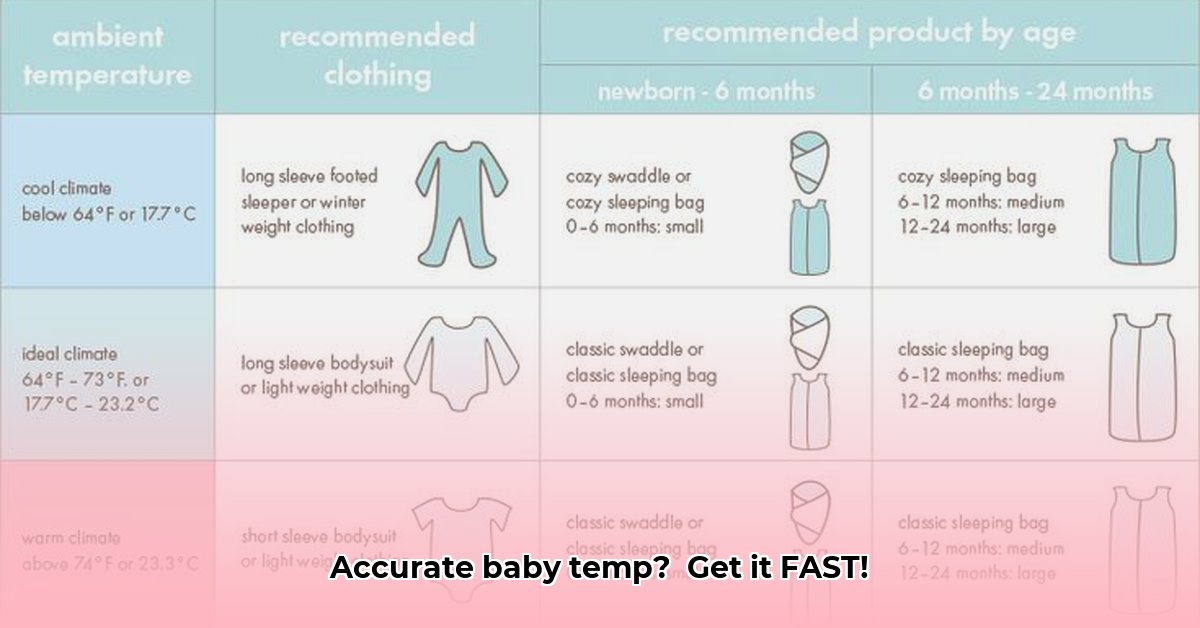
Taking your little one's temperature can be daunting, but this guide will equip you with the knowledge and confidence to do it correctly. Getting accurate readings quickly helps you make informed decisions about your baby’s health.
Choosing the Right Thermometer: A Comparison
Accurate temperature measurement is crucial. Different thermometers offer varying accuracy, ease of use, and safety. Here's a comparison to help you choose:
| Thermometer Type | Pros | Cons | Accuracy (0-3 months) | Accuracy (3-12 months) | Accuracy (12+ months) | Safety | Cost |
|---|---|---|---|---|---|---|---|
| Digital Axillary | Safe, widely available, relatively accurate. | Slower reading, susceptible to ambient temperature fluctuations. | Low | Low | Medium | High | Low |
| Tympanic (Ear) | Fast reading. | Accuracy can be inconsistent, especially in young infants. | Not Recommended | Medium-High | High | Medium | Medium-High |
| Temporal Artery (Forehead) | Quick, non-invasive. | Can be less accurate than rectal or axillary methods; susceptible to environmental factors. | Medium | Medium | Medium | High | Medium-High |
| Strip-Type (Forehead) | Simple, convenient. | Least accurate, provides only a general indication. | Very Low | Very Low | Very Low | High | Low |
For newborns (under 3 months), rectal temperature is generally considered most accurate, though it requires more careful technique. For older infants and toddlers, digital axillary (armpit) thermometers are a safer and convenient option. Always consult your doctor or healthcare professional for advice on the most suitable thermometer for your baby's age and health condition.
Step-by-Step: Mastering the Armpit Thermometer Technique
Accurate readings depend on correct technique. Follow these steps using a digital axillary thermometer:
- Prepare: Ensure your baby is calm and comfortable. Their armpit should be clean and dry.
- Position: Gently place the thermometer tip under your baby's armpit, ensuring good skin contact.
- Hold: Hold your baby's arm firmly against their body to prevent movement.
- Wait: Wait for the beep indicating the reading is complete (usually 2-3 minutes).
- Record & Clean: Note the temperature reading and clean the thermometer according to the manufacturer's instructions.
Remember, consistent technique is key to reliable measurements.
Decoding the Numbers: Understanding Infant Temperatures
Normal infant temperatures generally range from 36.4°C to 37.5°C (97.5°F to 99.5°F), but this can vary slightly between individuals. A temperature above 38°C (100.4°F) is typically considered a fever. However, always consult your doctor or healthcare professional for advice, particularly with young babies. Even a slightly elevated temperature accompanied by other symptoms warrants medical attention.
Understanding Fever in Infants: More Than Just a Number
A fever is your baby's way of signalling a problem. While a slightly elevated temperature might be normal, observe other symptoms such as lethargy (unusual sleepiness), poor feeding, vomiting, diarrhoea, rash, or unusual irritability. These, combined with a fever, could indicate a more serious issue. Your doctor can help you assess your baby's symptoms and provide appropriate guidance.
When to Seek Medical Advice: Prioritising Your Baby's Health
Prompt medical attention is crucial in certain situations:
- Under 3 months old with a fever: This is a medical emergency requiring immediate attention. Do not delay.
- High fever (above 38°C/100.4°F) with other symptoms: A high temperature coupled with lethargy, poor feeding, or other concerns needs immediate medical evaluation.
- Unusual lethargy or unresponsiveness: If your baby is unusually unresponsive or excessively sleepy, seek immediate medical attention.
- Signs of dehydration: Signs like dry mouth, fewer wet nappies, or sunken eyes indicate dehydration and require prompt medical care.
For babies older than 3 months, while you can monitor at home, always consult with your doctor if concerned.
Frequently Asked Questions (FAQs)
- Q: Why are my thermometer readings inconsistent? A: Inaccurate technique, improper thermometer placement, or environmental factors can cause inconsistencies. Ensure proper placement and follow instructions meticulously.
- Q: My baby has a slightly elevated temperature but seems well. Should I be concerned? A: Monitor your baby closely. While a slightly elevated temperature might not always indicate illness, contact your healthcare professional with any concerns.
- Q: Can I use an adult thermometer on my baby? A: While possible, baby thermometers are calibrated for more accurate low temperature readings.
In Closing: Your Baby's Wellbeing is Paramount
This guide provides valuable information, but it's not a replacement for professional medical advice. When in doubt, always consult your doctor or healthcare professional. Their expertise and support are invaluable in ensuring your baby's health and wellbeing.